Orange color paint is used on many occasions, such as when painting a ripe fruit, expressing warmth and skin tones. You can blend orange colors any way you want if you know how to mix orange with paint.
Orange color can be made by mixing red and yellow in a 1:3 ratio. The lightness or darkness of mixed orange can be changed by changing the ratio of red and yellow mixed. Cooler and warmer orange hues are mixed by using cooler and warmer red and yellow colors respectively. orange can be muted using blue.
Mixing orange is not just mixing yellow and red. The color bias of the mixed colors affects the final results. This knowledge of color mixing is needed when doing any kind of painting.
Below I have listed the key points you will be learning through this article. I have explained each of these points in detail below so that you can clarify any doubts.
Key takeaways:
- Orange color can be made using red and yellow mixed in a 1:3 ratio
- To mix vivid and vibrant orange colors, use cadmium red and cadmium yellow which are warm colors
- If cool yellow and reds such as lemon yellow and magenta are used, the mixed orange color will be less vibrant
- Mix a dash of blue to mute the orange color
- Green can be used to mute the orange color mildly
- Shades and Tints of orange can be mixed using black and white paints in different ratios
I have written a whole article about acrylic paint color mixing charts. You can learn a lot about mixing all the primary and secondary colors there. There is a free downloadable color mixing chart and a grid as well.
Two colors that make orange: yellow and red
The two colors that make orange are yellow and red. Mix a dash of red with a blob of yellow to create orange color. If you mix a lot of red you will get a reddish-orange color. If you mix less red, you will get a yellowish-orange color. You can check my results below where I have mixed pyrrole red and cadmium yellow in different ratios.

Let’s see how to make yellow-orange (Hex #ffae42).
Yellow-orange is the orange color leaning more towards yellow color. It can be made by mixing cadmium yellow medium, cadmium red light, and titanium white in a 12: 1: 6 ratio. It will yield a light orange color that is warm, vivid, and vibrant. Make sure to use warm red and orange colors.
The same process goes into making red-orange (Hex #ff5349).
Red-orange is the orange color leaning more towards red color. It can be made by mixing cadmium yellow medium, cadmium red light, and titanium white in a 1: 3: 1 ratio. It will yield a dark orange color that is warm, vivid, and vibrant. Make sure to use warm red and orange colors for mixing.
For the rest of the article, I will be using terms like hue, shade, and tints. Please refer to the color terminologies box below, if you want any clarification of the terms used.
Color Terminologies
There are different color terminologies you need to understand when discussing colors. I have described them below;
Hue: Hue means colors such as primary colors( red, blue, yellow) and secondary colors (orange, green, purple).
Value: The darkness or lightness of a color. Every color has a value. You can see this if you see a black and white photo of colors. Light colors like yellow are high in value while darker colors like red are low in value. The color black has the lowest value while the color white has the highest value.
Shade: Shade is the darker color you get when mixing a hue (color) with black. You can make dark to light shades by mixing in more or less black.
Tint: Tint is the color you get by mixing a hue (color) with white. By changing the amount of white you mix, you can get lighter tints.
Mass stone: Color of paint when painted thickly, straight out of the tube without diluting.
Undertone: Undertone can be seen when you scraped the paint on a white surface. Undertones can be different from mass tones because colors are not pure although there is a single pigment. Impurities of some colors give a different undertone. (e.g. Phthalo blue has a dark blue mass tone and greenish undertone)
Color bias: Every color (even primary colors) has a bias towards another color because there are hidden color pigments in the pure colors. (e. g. Phthalo blue has a green color bias while ultramarine blue has either green or red color bias)
Complementary colors: Colors on the opposite side of the color wheel. When complementary colors are mixed, a neutral or muted color will be made.
Cool colors: Cool colors are colors that remind you of the ocean and water. They include blue, green, and purple.
Warm colors: Warm colors will remind you of sun and fire. They are red, orange and yellow.
How to make orange without yellow?
In some cases, you might want to make orange paint without using yellow or red. So first let’s see, how to make orange without yellow.
The only way to make orange without yellow is to buy orange color paint. For lighter orange colors use Cadmium orange, Vat orange, or Pyrrol orange. For dark brownish orange colors use Quinacridone burnt orange. To make the orange color light or dark mix with white and a dark color respectively.
To darken the orange color there are several ways. You can mix it with the adjacent colors of orange on the color wheel. These colors are reddish-orange and yellowish-orange. You can also mix it with the complementary color of orange, which is blue. You can also mix in a dark neutral color like burnt umber and black colors.
When using darker colors, make sure to use only a dash of the color as they can overpower lighter colors easily.
However, you can make yellow colors by mixing green and orange. If you are interested on this read the following article; What colors make yellow? and mixing different yellow shades.
How to make orange without red?
To make orange without red, mix primary magenta and cadmium yellow medium in a 1: 2 ratio to make orange. The mixed orange color is less vivid as magenta has a blue color bias. Change the value of mixed orange by changing the ratio of magenta and yellow mixed, and mixing in white or dark colors.
Following is the orange color you will get by mixing magenta and yellow in a 1:2 ratio. The right side has tints of mixed orange color. I have used the Golden acrylic paint mixer to make the color swatches displayed in this article.
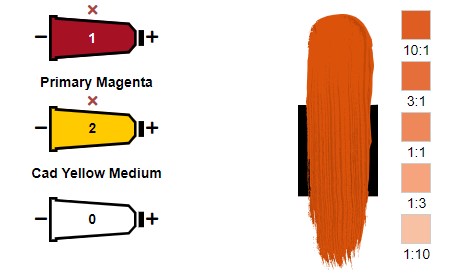
As mentioned before you can use orange color paint straight out of the tubes. This way you can have bright and vibrant orange without having to mix it.
I have written a detailed guide about mixing red without using red. You can find the best ratios to mix red there.
What 3 colors make orange?
I have seen many people have asked this question what 3 colors make orange.
You can mix orange with only two colors. They are red and yellow. However, you can use 3 colors to mix orange when you need to make shades or tints, change the value, and mute the mixed orange. Use black and white to make shades, and tints respectively, and change the value.
You can also change the value (darkness or lightness) of orange by changing the red and yellow amounts in the mix. The more yellow in the mix, the lighter the orange would be. The redder there is the darker the yellow would be.
Use paints with orange color pigments
Other than mixing orange color in different ways you can use orange straight out of the tube. There are different orange colors available in the market. Some of them are cadmium orange, pyrrole orange, light orange, perinone orange (or vat orange), and quinacridone burnt orange.
Let’s discuss more details about these paints, what they are made from and when to use them.
Cadmium orange is made by mixing cadmium yellow medium and cadmium red light in a 2:1 ratio. Cadmium orange is also available as single paint tubes. Change the yellow and red paint ratio to change the value. White and black can be mixed with cadmium orange to make shades and tints.
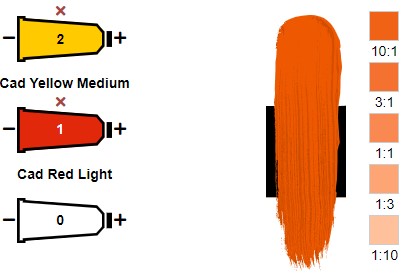
Perinone orange (or vat orange) is a saturated and intense, orange that leans toward red. Meaning it is a warm orange color. It can be used to paint skin tones and florals when thinned down. Thinning can be done with water or acrylic mediums if using acrylic paint.
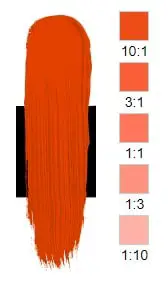
Quinacridone burnt orange is a transparent, rich, and deep orange color. It resembles a neutral reddish-brown color. Pyrrol orange is another very bright and vibrant semi-opaque orange color. It has a single synthetic pigment of PO73.
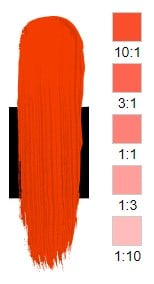
Color bias: warm and cool orange colors
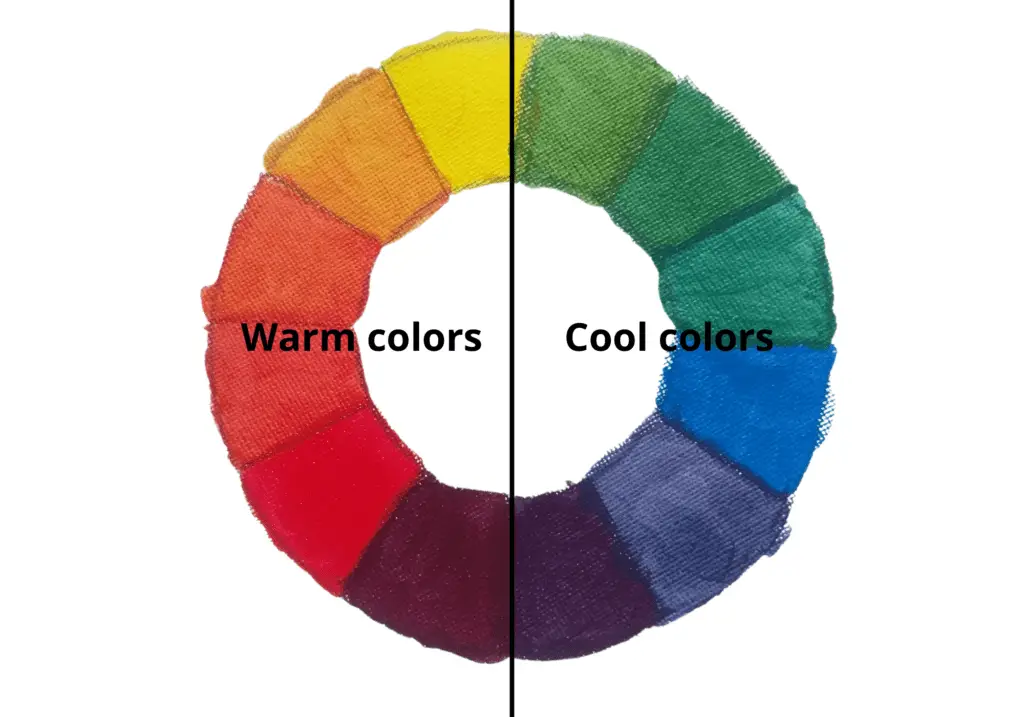
Overall orange is a very warm color. It reminds us of fire and warmth. However, you can make orange colors that are less vibrant and lean more towards the cooler side of the color wheel. When a cooler red or cooler yellow is mixed together to create orange, the resulting orange color will be cooler.
If you used warm red or warm yellow to make orange, the resulting orange color will be warmer, vivid, and vibrant. Let’s see the warmness and coolness of different yellow and red colors available. So that you will know what to expect from them.
Making orange with different yellows
In the art store, you will find different yellow colors. Some yellows lean toward red in the color wheel, thus they are warm yellows. Some yellow colors lean toward blues and thus they are cool yellow colors. Following are examples of cooler and warmer yellow colors.
Cooler yellow colors- Cadmium lemon, lemon yellow, bismuth yellow
Warmer yellow colors- Cadmium yellow, Winsor Yellow, and Indian yellow
Cooler yellow colors lean more toward blue. Warmer yellow colors lean toward red. The best yellow color to make orange would be warmer yellow color as orange is an overall warm color. It will yield bright and vibrant orange color that is saturated and intense. The best warm yellow color to use would be cadmium yellow medium.
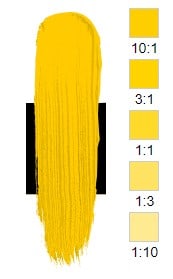
If you use cool yellow colors that lean toward blue color, the mixed orange color will be less vibrant. Because the green undertone in cool yellow colors will mute the red color and make an overall less vibrant orange color.
Making orange with different reds
Red is the other color used to make orange. As there are many red color paints, it is important to pick the right one. Although red is a warmer color, some red colors have a color bias. It is important to pick warm red colors with a warm color bias for the vibrant orange color.
Cooler red colors- Alizarine crimson, Quinacridone magenta
Warmer red colors- Cadmium red, Cadmium red light, pyrrole red
The warmest red color is cadmium red light. You can mix a bright and vibrant orange color with it. It has a yellow color bias. The next warmest red color is cadmium red. It also has a yellow color bias. You can use either of these cadmium reds to make the vivid vibrant orange color.
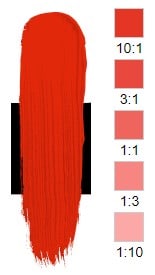
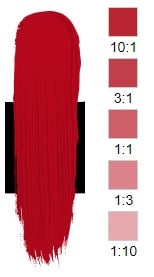
The coolest red color is Quinacridone magenta. It leans toward blue. If you use Quinacridone magenta to, make orange the orange color will be less vibrant. But it is best to mix purple. Alizarine crimson is the next coolest red color. It also leans blue and is best to mix purple color.
I have experimented by mixing both cooler and warmer red and yellow colors to mix orange. Below you can see my results.


Check the image of orange colors mixed with cadmium lemon. The colors look less vibrant compared to orange colors mixed with cadmium yellow. When looking at the red color notice the vivid vibrant orange color made by cadmium red followed by pyrrole red. So the best option to mix orange would be cadmium red and cadmium yellow colors.
How to create vivid and vibrant orange
Vivid and vibrant orange colors can be made by mixing red and yellow colors that have a warm color bias. The best colors to use would be cadmium red light and cadmium yellow medium mixed in a 1:2 ratio. Make sure to avoid red and yellow colors with cool color bias such as lemon yellow and magenta.
Mute the orange color: Mixing blue, green, and neutral colors
In some cases, you will find that orange is very overpowering. In these cases, you can mute the orange color and make a duller one. To do this you need to mix the orange color with its complementary color in the color wheel which is blue. Mix in only a dash of blue color with orange.
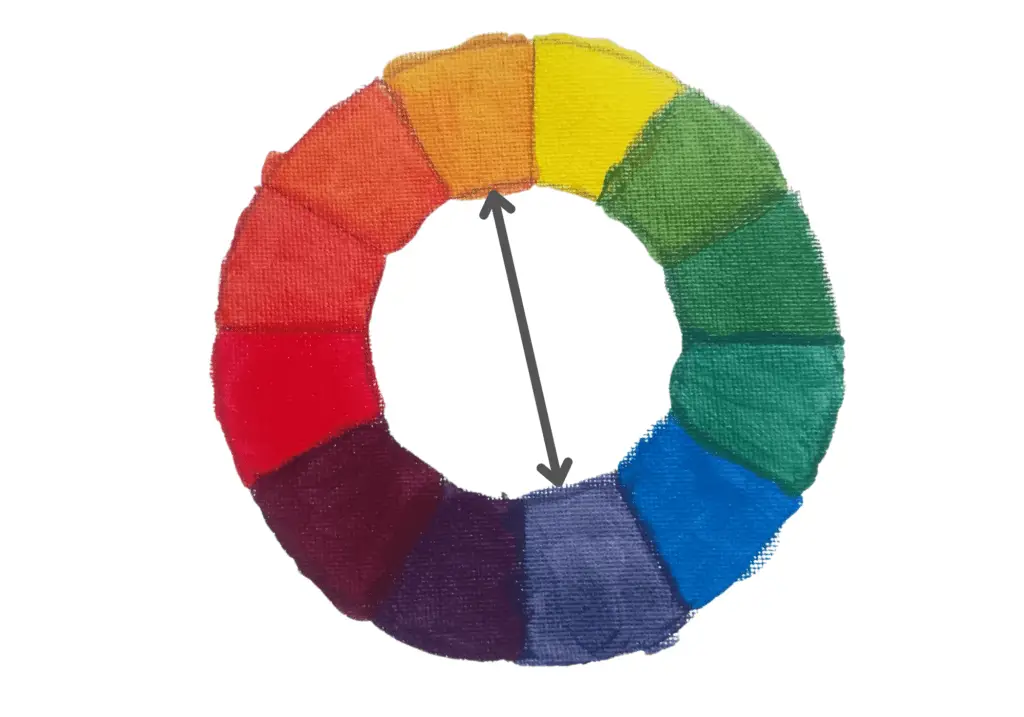
Following is the result I have got after mixing orange with blue.
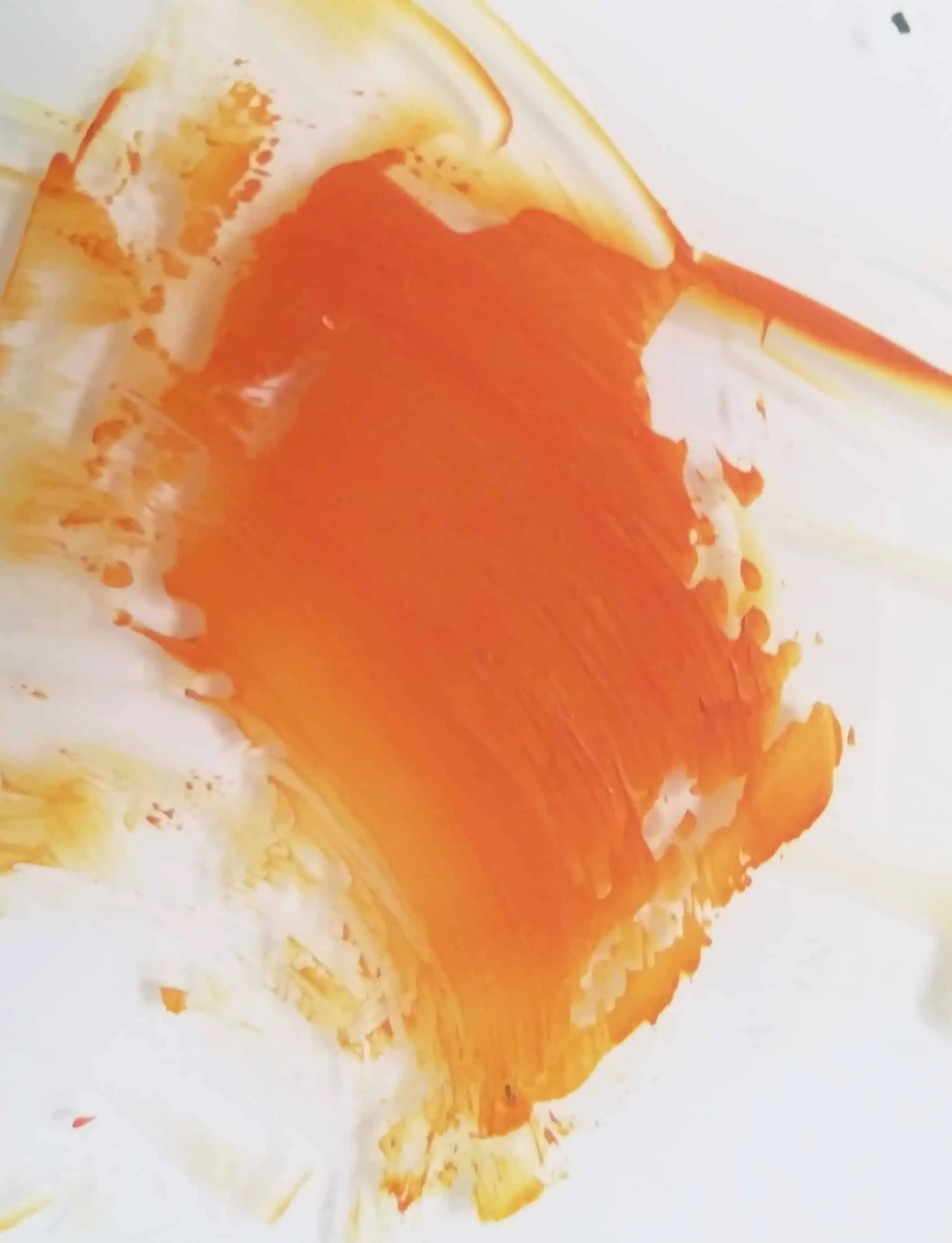
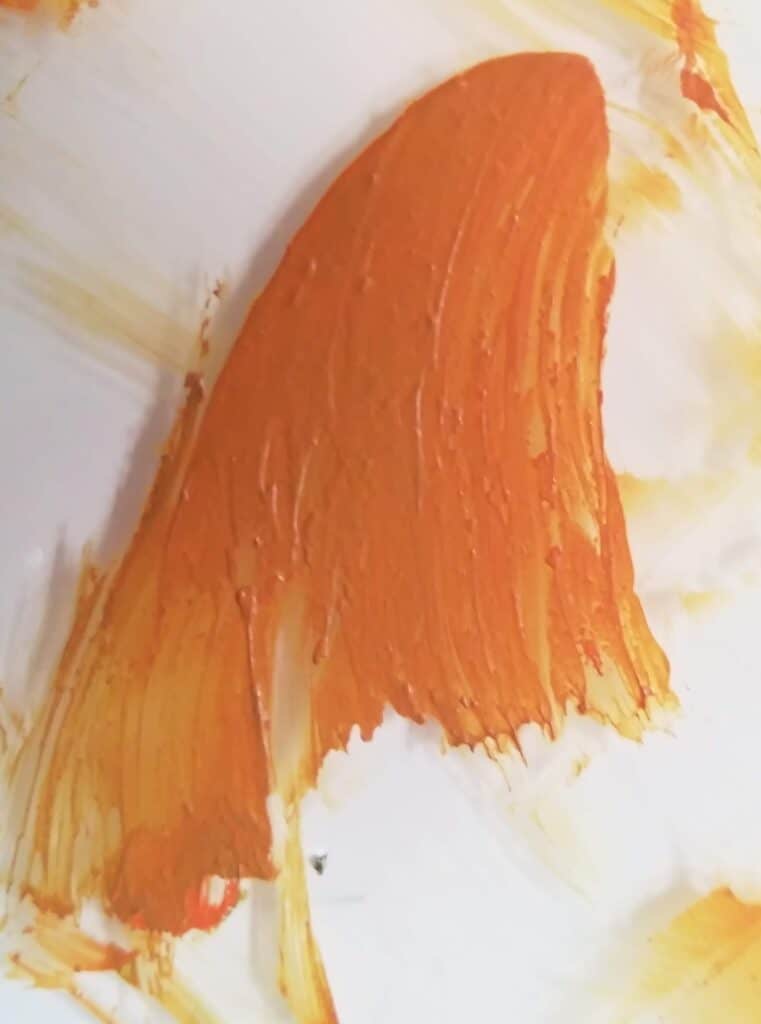
The vibrant orange color in the image is mixed with warm red and yellow colors which are cadmium red and cadmium yellow. The less vibrant color is mixed with cadmium lemon which is a cool yellow color with cadmium red.
Both of these colors got a brownish hue when mixed with blue. This is because all the warm colors make brown when muted with its complementary color. Make sure to mix only a dash of blue. Otherwise, you will make a dark brown color.
Another way to mute the orange color is by mixing it with a dash of green. It will mute the orange color mildly. You can also use yellow or red with a cool color bias to mix less vibrant or muted orange colors. Mixing with burnt umber, burnt sienna or grey are other options to mute the vibrant orange color.
Mixing different shades and tints of orange
Shades and Tints of orange color are made by mixing black or white in different ratios. These shades and tints can be used in a painting to change the value (lightness or darkness of a color). Following are the shades and tints of cadmium orange.
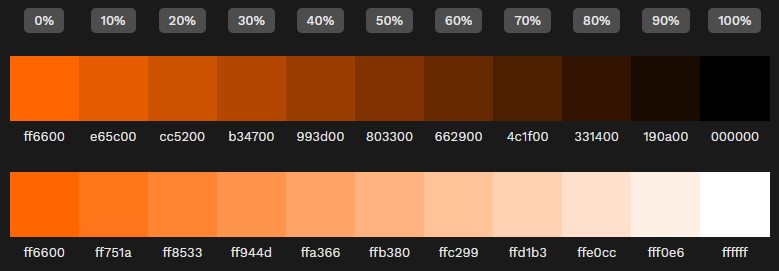
The percentage of black or white mixed is indicated at the top of the image. You can refer to this color chart and the percentage of black and white that need to be mixed when doing a painting. You can also mix orange with grey, instead of mixing with black which can be easily overpowering.
Mixing different hues of orange using different colors
There are different hues of orange color. You can mix them by combining several paint colors. Below I have included different orange hues, their hex codes, RGB, and CMYK values. I have included what colors you need to mix if you are painting to make the particular orange color.
The paints I have mentioned below are related to Golden Heavy Body Acrylic paints obtained through a Golden color mixer. But it is highly related to the same color of different types or brands of paint.
Orange-Red: 49 Pyrrole Orange * 1 Light Bismuth Yellow
Hex #FF4500
RGB 255, 69, 0
CMYK 0, 73, 100, 0
Yellow-Orange: 46 Diarylide Yellow * 2 Pyrrole Orange * 1 Dioxazine Purple * 49 Titanium White
Hex #FFA836
RGB 255, 168, 54
CMYK 0, 34, 79, 0
Tomato: 12 Pyrrole Orange * 1 Cadmium Orange * 7 Zinc White
Hex #FF6347
RGB 255, 99, 71
CMYK 0, 61, 72, 0
Pumpkin: 49 Cadmium Orange * 33 Nickel Azo Yellow * 16 Titanium White * 1 Pyrrole Red Light
Hex #F5761A
RGB 245, 118, 26
CMYK 0, 52, 89, 4
Carrot Orange: 2 Cad Yellow Medium * 1 Cadmium Orange * 2 Zinc White * 2 Yellow Ochre
Hex #ED9121
RGB 237, 145, 33
CMYK 0, 39, 86, 7
Vermilion: 26 Cad Red Light * 18 Cadmium Orange * 4 Titanium White * 1 N3 Neutral Gray
Hex #D74826
RGB 215, 72, 38
CMYK 0, 67, 82, 16
As you can see most orange hues needed cadmium orange or pyrrole red to mix the particular hue. Therefore it will be beneficial to add them to your color collection.
Steps of mixing an orange color to match a reference
Now that we know all the basics of mixing orange colors, let’s match an orange color of a reference photo. There is a set process to this. I will explain it step by step related to the following reference image of an orange.
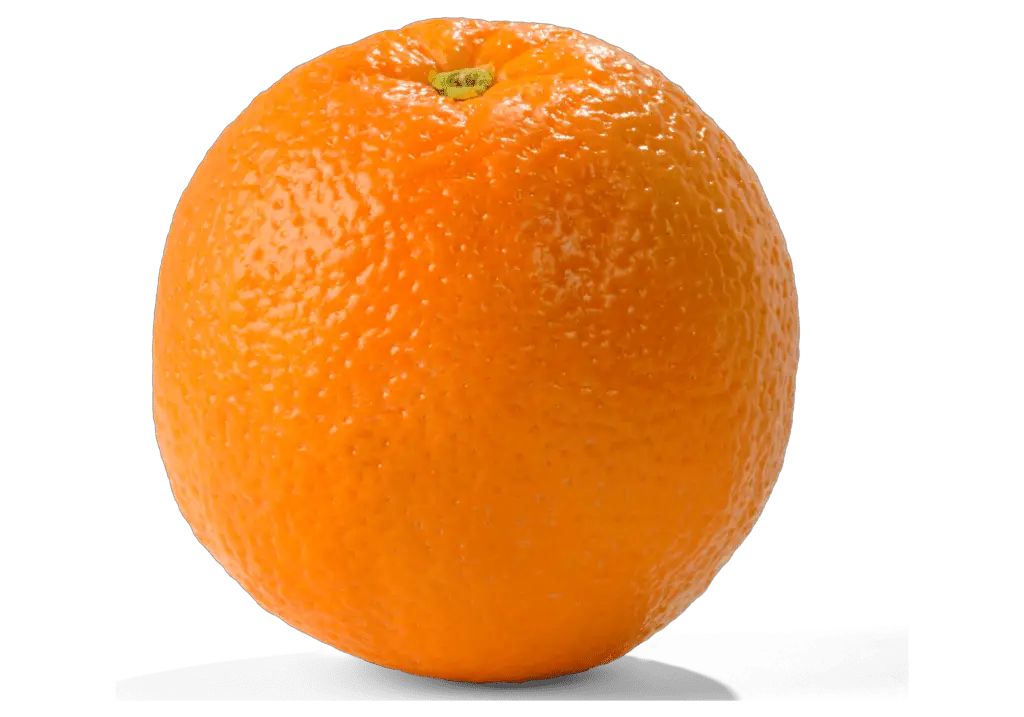
Step 1: Make a color wheel with cyan, yellow, and magenta (CMYK) or red, yellow, and blue (RYB) as the primary colors. You can also refer to the color wheel I have made. It is best when you have a color wheel for the particular paints you are using. The following video will help you make a color wheel.
Step 2: Match the hue of the orange in the reference photo to a hue in the color wheel. The best match for the orange hue of orange is the yellowish-orange color. This yellowish-orange color can be made by combining cadmium red and cadmium yellow colors. This tertiary color in the color wheel is more yellowish. Therefore mix in more cadmium yellow.
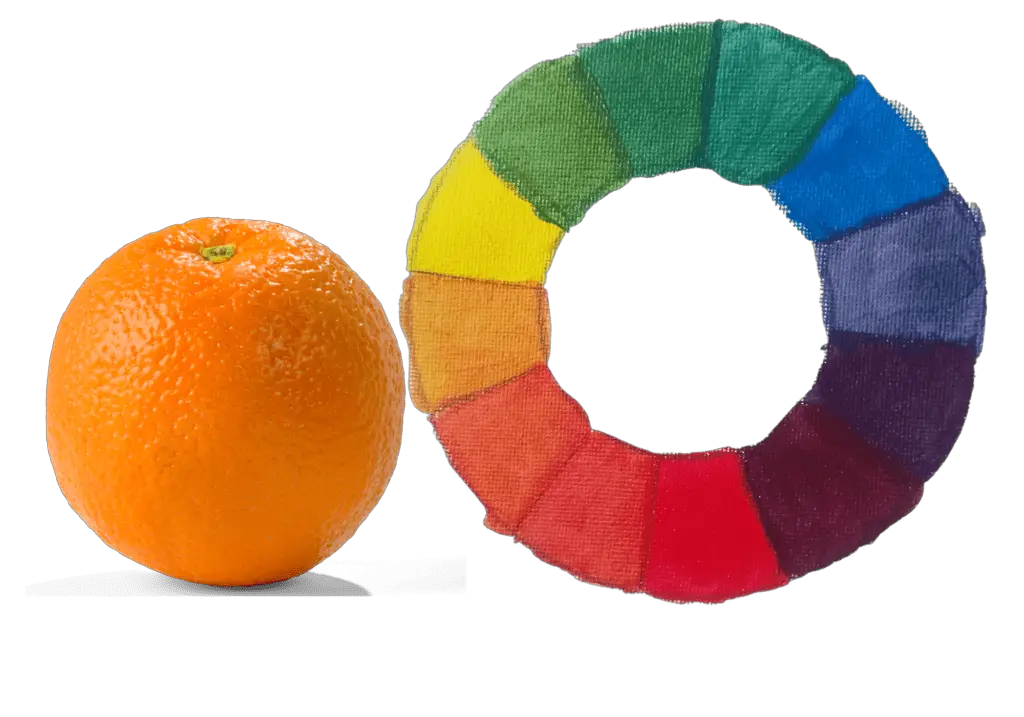
Step 3: Determine the vividness or dullness of the reference color. If it is a dull color you need to mix the complementary color and mute the yellow hue. As you can see the darker shadows of orange are dull and not vivid. We will need to mix muted yellowish-orange colors for the shadows.
However, the lighter areas of orange are vivid and vibrant which matches the vividness of the yellowish-orange color in the color wheel. Therefore the vividness matches the orange hue in the color wheel.
When making vivid and vibrant colors the quality of the color you are using matters. As you can see the paints in my color wheel are thin and sometimes not vibrant. This is because of using student-grade acrylic paint. Therefore to get the best out of your paints use artist-grade acrylic paint.
The best choice for artist-grade acrylic paint that I recommend is Golden acrylic paint (Link to view on Blick Art Material). They are pioneers of acrylic paint and offer the best quality.
If you can not afford artist-grade acrylic paint, you can use high-quality student-grade acrylic paint. I have written a whole article about comparing 5 student grade acrylic paints and picking a winner. You can make the best choice for affordable acrylic paint by reading that article.
Now back to the color matching steps…
Step 4: Next match the value of the color. In some parts of the orange, you will see higher values and other parts have lower values. To increase the value of the painting mix in some cadmium yellow or white. To decrease the value mix in more cadmium red or dark neutral colors like black, grey, or brown. Only mix in a dash of dark colors.
This way you can change the value of the orange color mixed to match any colors of the orange. This is the exact process you need to follow to match any color to a reference.
Meaning of different orange hues, shades, and tints
Orange is the warmest color for the human eye. Therefore it is used to express the heat of flames, creativity, and invigoration. There are different hues of orange as mentioned before. Each one of those hues has a meaning. Let’s get to know what is meant by those orange hues.
Below I have included a table with different orange hues and where they are best suited to your artwork.
| Yellow color | Hex code | What the color represents |
| Orange-Red | #FF4500 | This reddish-orange color is used to represent joy, warmth, and passion |
| Yellow-Orange | #FFA836 | This yellowish-orange is the same as the color of sunshine. It is used to convey happiness and enthusiasm in a painting. |
| Tomato | #FF6347 | This is the reddish-orange color of a tomato. |
| Pumpkin | #F5761A | This is the yellowish-orange color of pumpkin |
| Carrot Orange | #ED9121 | This is a darker orange color of carrot |
| Vermilion | #D74826 | This bright and intense orangish-red color is used as the color of blood, and thus used as the color of life |
